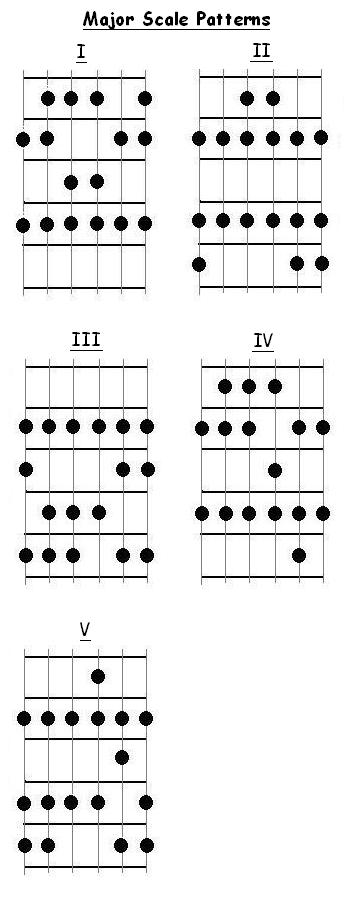
Welcome to FreeGuitarCourse.com!
For Sitemap click the underlined FreeGuitarCourse.com logo above.
Join our free newsletter for site updates, tips, & tricks!
The Five Condensed Major Scale Patterns for Guitar
OK, by now you should be gaining a little bit of fluency in your major scale pattern and your C-F-G chord progression. If not, keep practicing, it will come to you! We will now add four more major scale patterns to your repertoire. It is VERY IMPORTANT that you work diligently on these major scale patterns, as they are the basis of the seven modes of the major scale. Mastering these patterns will open up a whole range of lead skills.
It is important to understand the difference between a scale and a scale pattern. A scale is a specific progression of notes, such as C-D-E-F-G-A-B. A scale pattern is also a progression of notes, but it is not specific to any one key. For instance, if you play the major scale pattern we learned earlier, and you start at the C note on the sixth string, 8th fret, you will be playing a C major scale. However, if you start the major scale pattern on the sixth string, 5th fret, you will be playing an A major scale. A scale is a specific progression of notes, whereas a scale pattern is a specific progression of steps. The pattern is moveable, see? So once you memorize the major scale pattern, you have memorized a way to play the major scale in 12 different keys. If you were learning the fretboard in terms of musical notation, you would be learning note-specific patterns for every key. With the pattern you get a 12-for-1 deal: 1 pattern covers 12 keys. Now for the kicker. By shifting the five patterns around a bit, you can play in different modes. More on that later, for now just know that these five patterns will ultimately fill your toolbox with seven modes in 12 keys, for a grand total of 84 different lead patterns! Do you see why it is so important to practice these scales?!
So here they are, all five, including the one you are already practicing:

You already have one under control, so you only have four new ones to learn.
Now, pay attention to this. The lower notes of pattern 2 are the upper notes of pattern 1 (upper and lower are in reference to the guitar neck, NOT the computer screen! So the 1st fret is lower than the second fret, etc.). The lower notes of pattern 3 are the upper notes of pattern 2. And so on. Look at them for a moment and you will see what we mean. Notice that the upper notes of pattern 5 are the lower notes of pattern one, so the whole block of five patterns repeats at some point on the fretboard, depending on what key you are starting in. The importance of this is the fact that you can move from one pattern into another without leaving the major scale, which adds a lot of potential variety to your soloing. With these five patterns in your toolbox you can solo across the fretboard or along the length of the fretboard. Experiment with this and you will see what we mean. We recommend making it a point to memorize the patterns as shown, then begin to move along the fretboard among the patterns as you progress. With these five patterns under your control, you will be able to play improvisational solo over a lot of popular radio station programming. You’ll see what we mean, just practice, practice, practice for now!
